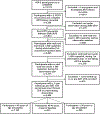Aging, trends in CD4+/CD8+ cell ratio, and clinical outcomes with persistent HIV suppression in a dynamic cohort of ambulatory HIV patients
- PMID: 35013081
- PMCID: PMC11004734
- DOI: 10.1097/QAD.0000000000003171
Aging, trends in CD4+/CD8+ cell ratio, and clinical outcomes with persistent HIV suppression in a dynamic cohort of ambulatory HIV patients
Abstract
Background: Age blunts CD4+ lymphocyte cell count/μl (CD4+) improvements observed with antiretroviral therapy (ART)-induced viral suppression among people with HIV (PWH). Prolonged viral suppression reduces immune dysregulation, reflected by rising CD4+/CD8+ ratios (CD4+/CD8+). We studied CD4+/CD8+ over time to determine whether it predicts risk for select comorbidities and mortality among aging PWH with viral suppression.
Methods: We studied HIV Outpatient Study (HOPS) participants prescribed ART during 2000-2018 who achieved a viral load less than 200 copies/ml on or after 1 January 2000, and remained virally suppressed at least 1 year thereafter. We modeled associations of CD4+/CD8+ with select incident comorbidities and all-cause mortality using Cox regression and controlling for demographic and clinical factors.
Results: Of 2480 eligible participants,1145 (46%) were aged less than 40 years, 835 (34%) 40-49 years, and 500 (20%) ≥ 50 years. At baseline, median CD4+/CD8+ was 0.53 (interquartile range: 0.30-0.84) and similar among all age groups (P = 0.18). CD4+/CD8+ values and percentage of participants with CD4+/CD8+ at least 0.70 increased within each age group (P < 0.001 for all). CD4+/CD8+ increase was greatest for PWH aged less than 40 years at baseline. In adjusted models, most recent CD4+/CD8+less than 1.00 and less than 0.70 were independently associated with higher risk of non-AIDS cancer and mortality, respectively.
Conclusion: Pretreatment immune dysregulation may persist as indicated by CD4+/CD8+ less than 0.70. Persistent viral suppression can improve immune dysregulation over time, reducing comorbidity, and mortality risk. Monitoring CD4+/CD8+ among ART-treated PWH with lower values provide a means to assess for mortality and comorbidity risk.
Copyright © 2022 Wolters Kluwer Health, Inc. All rights reserved.
Conflict of interest statement
Conflicts of interest
F.J.P. has been a consultant and/or on the Speakers’ Bureau for Gilead Sciences, Janssen Pharmaceuticals, Merck and Co., and ViiV. R.M.N. is a consultant to ViiV and Gilead Sciences.
Figures






References
-
- Haynes BF, Markert ML, Sempowski GD, Patel DD, Hale LP. The role of the thymus in immune reconstitution in aging, bone marrow transplantation, and HIV-1 infection. Annu Rev Immunol 2000; 18:529–560. - PubMed
-
- Provinciali M, Moresi R, Donnini A, Lisa RM. Reference values for CD4+ and CD8+ T lymphocytes with naïve or memory phenotype and their association with mortality in the elderly. Gerontology 2009; 55:314–321. - PubMed
-
- Rosado-Sanchez I, Herrero-Fernandez I, Genebat M, Ruiz-Mateos E, Leal M, Pacheco YM. Thymic function impacts the peripheral CD4/CD8 ratio of HIV-infected subjects. Clin Infect Dis 2017; 64:152–158. - PubMed
-
- Serrano-Villar S, Moreno S, Fuentes-Ferrer M, Sánchez-Marcos C, AvilaM Sainz T, et al. The CD4:CD8 ratio is associated with markers of age-associated disease in virally suppressed HIV-infected patients with immunological recovery. HIV Med 2014; 15:40–49. - PubMed
-
- Kaufmann GR, Bloch M, Finlayson R, Zaunders J, Smith D, Cooper DA. The extent of HlV-1-related immunodeficiency and age predict the long-term CD4T lymphocyte response to potent antiretroviral therapy. AIDS 2002; 16:359–367. - PubMed
Publication types
MeSH terms
Substances
Grants and funding
LinkOut - more resources
Full Text Sources
Medical
Research Materials

